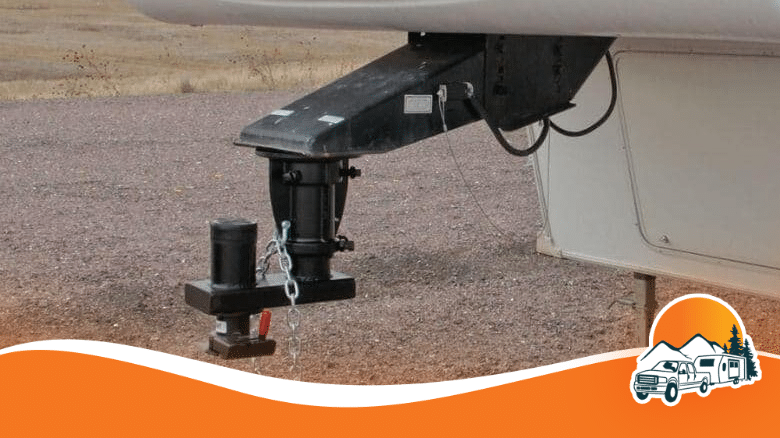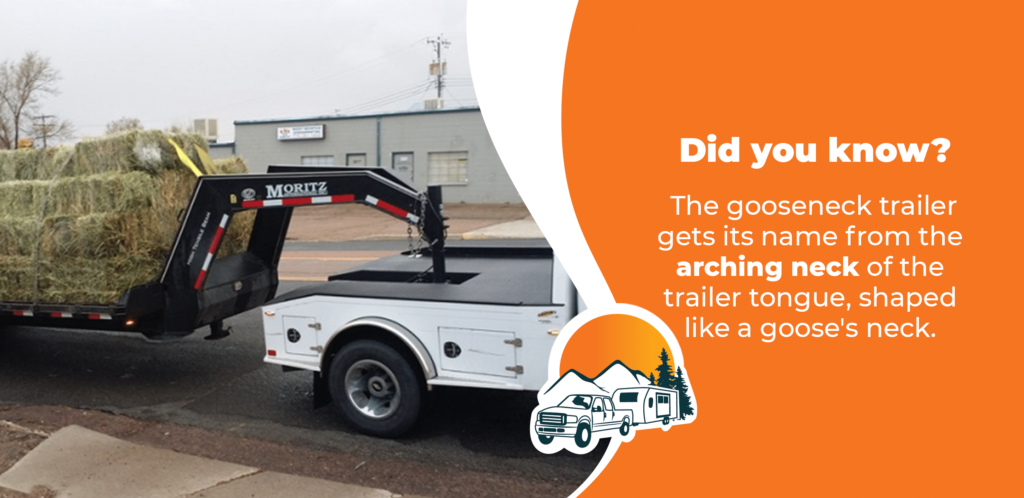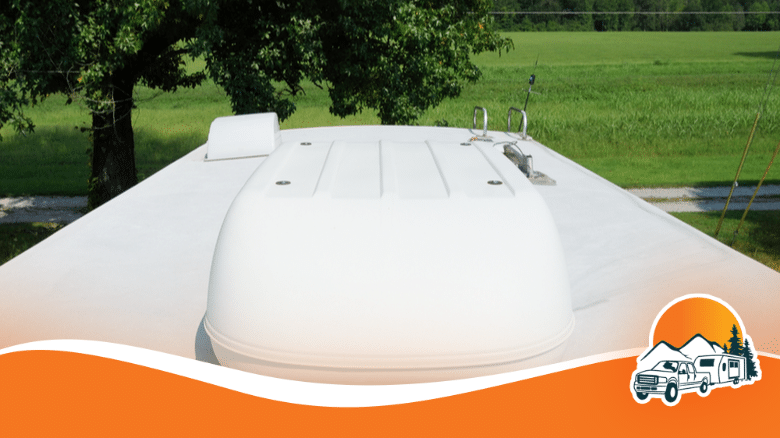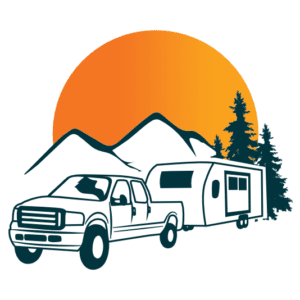Now that you have started your RVing journey with a fifth wheel, you might have heard the terms “5th wheel adapter to gooseneck adapter” thrown around.
It’s no secret that familiarizing yourself with fifth-wheel gooseneck adapters is an essential part of smoothly towing your trailer.

In this article, we’ll look at what exactly is the 5th wheel to gooseneck adapter, how it works, and whether it’s safe.
- What Is a 5th Wheel to Gooseneck Adapter?
- How Does a 5th Wheel to Gooseneck Adapter Work?
- What are the Differences and Similarities Between a Fifth Wheel and a Gooseneck?
- Is a 5th Wheel to Gooseneck Adapter Safe?
- Can You Convert a Fifth Wheel to a Gooseneck?
- Factors to Consider Before Buying a Fifth Wheel to a Gooseneck Adapter
- Fifth Wheel To A Gooseneck Adapter: Pros & Cons
- FAQs
- Ending Thoughts
What Is a 5th Wheel to Gooseneck Adapter?
When you’re buying a fifth wheel, you’ll need the two main types of trailer hitches for towing — a fifth-wheel hitch or a gooseneck hitch.
Fifth Wheel Hitch
A fifth wheel hitch is a type of hitch in a truck that connects a long fifth wheel trailer’s kingpin. A pivoting head plate on the hitch secures the kingpin with metallic clamps or a lock, and a rotating head plate on the hitch that provides ample mobility so you can tow the vehicle efficiently.
Weight capacities range from 16,000 to 30,000 pounds for fifth-wheel hitches. This is the most popular type of fifth wheel hitches for towing RV trailers and bulky motorhomes.
Gooseneck Hitch
A gooseneck hitch is a hitch ball that ties a truck bed to a gooseneck trailer. The hitch’s main body is usually fixed beneath the truck bed and fastened to the truck frame with brackets.
Gooseneck hitches are commonly used to tow cattle trailers, horse trailers, and flatbed equipment carriers and are generally rated for pulling up to 30,000 lbs or more.
If you need to use a gooseneck hitch in the bed of your truck, but your trailer only has a regular fifth wheel kingpin pinbox; here are a few alternatives:
- Swap out the pinbox for something like a gooseneck pinbox.
- Connect the 5th wheel to the gooseneck adapter to the kingpin.
- Mount the gooseneck ball with a specific hitch.
Put simply: The essential purpose of these fifth wheel to gooseneck adapters is to connect the fifth wheel hitch of your truck to the gooseneck hitch or vice versa.

How Does a 5th Wheel to Gooseneck Adapter Work?
There’s no rocket science involved here. You don’t need to require a lot of RVing or trucking experience to know the mounting technique or to use one of these adapters. The adapter’s purpose is to assist the fifth wheel in using the gooseneck hitch present in your truck.
It’s basically a metal tube that connects straight to your fifth wheel’s kingpin. That connection gives the ball adequate length to attach to the gooseneck hitch. That’s pretty much it for the adapter’s functionality.
The adaptor is secured in place by giant metal screws, which ensures that the trailer does not move while traveling over uneven roads. While this is more of a more straightforward design, other more sophisticated ones are also available.
These adapters will vary in price, so you’ll have to research before making your final decision. This is to ensure that you select one that can adequately carry the weight of your fifth-wheel trailer while also providing sufficient security to prevent your trailer from separating.
What are the Differences and Similarities Between a Fifth Wheel and a Gooseneck?
There are a couple of differences between a fifth wheel and a gooseneck hitch.
Differences
Gooseneck hitches are ball attachments that are positioned in a truck’s bed. They are far less bulky and don’t take up a lot of space in your truck bed.
On the other hand, fifth wheel hitches have jaws and kingpin connections. While the fifth wheel also fits into the truck bed, it takes much more space in the truck bed, leaving little room for any other load.
Goosenecks are used to tow industrial and horse trailers, while the fifth wheels are specific only to RVs.
Another difference between the two hitches comes with the type of trailers they can fit in. Goosenecks are compatible with the attachment mechanism of various trailer types, but fifth wheels only work well with fifth-wheel trailers.
The price point, too, is a significant difference between the two hitches. Gooseneck hitches are much cheaper than the fifth wheel hitches.
Similarities
Despite these differences, both the hitches share many similarities.
Both fifth wheel and gooseneck hitches must be physically put into a truck’s frame. They both have permanent components that you need to place into the truck’s bed. Keep in mind that these components cannot be removed after each use.
Furthermore, only trucks can be equipped with fifth wheel and gooseneck hitches. Neither of these attachments can or should be installed on any other vehicle. A truck bed’s broad, level, and solid surface is critical to its proper operation.
Both gooseneck and 5th wheel hitches must sit above the truck’s main axle to achieve a strong foundation. Because this is the truck’s strongest and sturdiest component, they’re both installed at the same position.
Both of these hitches are also simple to connect to. They sit securely in your truck bed and merely need to be backed into position beneath the appropriate trailer. There isn’t a lengthy installation process, including additional equipment for each connection.
Finally, both fifth wheel and gooseneck hitches can make tight turns with the vehicles they tow. It can be difficult for the tow vehicle to make turns and back up with many towing accessories.
However, thanks to the fifth wheel hitch’s swiveling functions and the smooth sliding of the gooseneck’s ball hitch, the whole process becomes considerably more manageable.
Is a 5th Wheel to Gooseneck Adapter Safe?
The fifth wheel to gooseneck adapters is generally safe as long as you remain underweight. For instance, if you have a 15,000 lbs 5th wheel and your adapter is rated to 25,000 lbs of gross trailer weight, this will typically be safe.
While they are safe, 5th wheel to gooseneck adapters are not recommended for long-term use and should only be used as a temporary solution when you need to convert the trailer to a gooseneck in the absence of a standard 5th wheel kingpin pinbox.
If you plan on using a gooseneck hitch long-term, it would be best to simply replace your 5th wheel pin box with a gooseneck pin box.
Can You Convert a Fifth Wheel to a Gooseneck?
Yes, you can convert your fifth wheel to a gooseneck by using an adapter. The adapters vary depending on your truck bed sizes and camper measurements.
The most common components used in a fifth wheel to gooseneck conversion are — a fifth wheel adapter plate or a fifth wheel gooseneck hitch.
Factors to Consider Before Buying a Fifth Wheel to a Gooseneck Adapter
Getting the 5th wheel to gooseneck adapter can be a challenging decision. You must be fully aware of what to consider before buying one. Here are a few essential factors to keep in mind.
The Towing Capacity And Weight of the Trailer.
Two of the most critical points to consider when buying an adapter are the towing capacity and the gross weight of your trailer.
The maximum weight your truck can tow is referred to as towing capacity. The gross weight of your trailer is that weight when your trailer is loaded and hitched to the truck.
In general, the gross weight of a trailer should never exceed the truck’s towing capacity, even if the trailer is not loaded to its maximum capacity.
Your Truck’s Bed Length
Once you have determined your towing capacity, you’ll need to determine the length of the bed of your truck. We’ll use the phrases short-bed and long-bed to keep things simple.
When your truck and trailer are coupled up, the length of the truck bed affects how much space you’ll have. A truck with a long bed typically has more clearance, whereas a short bed has less. This helps you decide the mounting platform for your type of hitch.
A Puck System
A puck system is a built-in mounting platform that comes as a standard on many modern pickup trucks, especially those with a built-in towing capacity. It has a gooseneck hole in the middle and four connection points, or “pucks.”
If you have a puck system in your truck bed, it gets easier to install the fifth wheel to the gooseneck adapter.
Fifth Wheel Rails Might Be Permanent Or Removable.
If your truck does not have a puck system, fifth-wheel base rails are the usual way to install a fifth-wheel hitch.
Depending on your preferences, you can install permanent or detachable base rails.
Height of the Adapter
Measuring the distance from the truck bed to the kingpin plate is a common mistake most RVers make. Instead, measure the distance between the top of the gooseneck ball and the kingpin plate.
The reason for this is that the height of an adapter determines how much higher the trailer is elevated from the top of the ball.
The total height of the adapter hardware is not included in the measurements. If you measured the outside of the adapter with a tape measure, it would be larger than its rating.
Here’s how you measure the height correctly:
- Place the truck below the camper.
- You must level the trailer.
- On your trailer, measure from the top of the ball hitch to the bottom of the king plate (top of the kingpin).
Fifth Wheel To A Gooseneck Adapter: Pros & Cons
Here are a few advantages and disadvantages of using a fifth wheel to a gooseneck adapter.
Pros
The main advantage of this adapter is that it allows you to tow a fifth-wheel trailer with a gooseneck hitch without making any significant modifications to your truck.
What’s more, this also allows you to switch between different trailer types easily.
Besides that, the adapters are really simple to install and remove as needed.
The ball on these is likewise a standard size, making it easy to haul trailers down.
It’s also simple to add plates to the adaptor, allowing users to change weight and stabilize their vehicle.
Cons
There are two primary disadvantages to using the adapter.
For starters, the weight capacity is generally low(under 20,000 to 25,000 pounds). Going above can be risky since your adapter may become loose.
Apart from this, you need to be selective with installing the type of gooseneck hitch on your adapters because some of them can put too much strain on the device, potentially breaking or damaging your vehicle.
These are the issues solely related to the use of the adapters. Lastly, the high cost of such adapters can also be a nuisance.
FAQs
Here are a few commonly answered questions about adapting a 5th wheel to a gooseneck hitch.
Can you pull a gooseneck trailer with a bumper hitch?
In general, bumper pull hitches are unsuitable for gooseneck trailers. Gooseneck trailers are built to tow large, heavy loads. They can handle loads weighing more than 30,000 pounds. However, the bumper towing capacity is capped at 30,000 pounds.
The load capacity and the stability of the hitch make it highly prone to accidents.
Should a gooseneck trailer be level when towing?
To increase stability, the braking capacity, and ground clearance, trailers should be level when towing. Poor towing characteristics such as instability and uneven tire wear can be prevented with a level trailer. If leveling the trailer isn’t possible, the next best alternative is to lower the trailer’s nose.
It is necessary to level the trailer for safety as well. Traveling with an unlevel trailer might put you and other cars on the road in danger. Furthermore, the wear and tear can also result in costly repairs.
Should a fifth wheel be level when towing?
A fifth wheel should be level when towing to avoid any strain on the camper. Besides the strain, the vehicle’s tires will be negatively affected, and the overall performance will drop.
Is it better to have the trailer tongue higher or lower?
It’s always best to level your trailer tongue. If the trailer tongue is higher, the tongue weight is low. It will result in a swaying trailer. A lower trailer tongue, on the other hand, means the trailer is overloaded. This makes it harder to take turns.
Ending Thoughts
The 5th wheel to gooseneck adapters is an excellent choice for improving the versatility of your vehicle for towing. Even if your camper or truck is not equipped with a standard 5th wheel kingpin, you can still use a gooseneck hitch by using an adapter.
However, the manual fitting problems and high prices of 5th wheel to gooseneck adapters can be a concern. Moreover, you risk possible damage to your vehicles as well. So it’s always a good idea to seek the advice of an expert before investing in a 5th wheel to a gooseneck adapter.
Have you used a 5th wheel to a gooseneck adapter? We would love to know about your experience in the comment section below!







